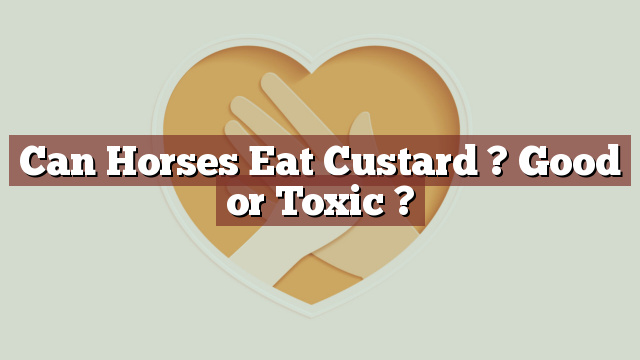Can Horses Eat Custard? Good or Toxic?
Ensuring the well-being of our horses is of utmost importance to every responsible horse owner. As such, it is crucial to be aware of the foods that are safe and suitable for our equine companions. In this article, we will explore the topic of whether horses can eat custard, and evaluate its nutritional value, safety, and potential risks.
Nutritional Value of Custard: Is it Suitable for Horses?
Custard is a creamy dessert that typically consists of milk, eggs, sugar, and flavorings such as vanilla. While custard may be considered a delightful treat for humans, it is important to evaluate its nutritional content before considering it as an option for our horses. Custard is relatively high in sugar and fat content, which can make it unsuitable for equine consumption. Horses have specialized digestive systems that are adapted to a diet primarily consisting of forage, such as grass and hay, and introducing foods high in sugar and fat can disrupt their digestive balance.
Can Horses Eat Custard? Safety and Potential Toxicity Explained
Unfortunately, horses should not consume custard as it can be potentially harmful to their health. The high sugar and fat content in custard can lead to digestive upset, including diarrhea and colic. Additionally, the presence of artificial flavors and additives in some custard recipes can further increase the risk of adverse reactions or allergies in horses. It is best to avoid offering custard to horses altogether.
Scientific and veterinary insights support the notion that horses are herbivores with specific dietary requirements. Their digestive systems are designed to efficiently process plant-based materials, and any deviation from their natural diet can have negative consequences. While horses may be curious and willing to sample a variety of foods, it is essential to prioritize their health and stick to a diet that aligns with their specific nutritional needs.
Potential Risks and Benefits of Feeding Custard to Horses
Feeding custard to horses poses several risks that can potentially compromise their well-being. The high sugar and fat content can lead to weight gain and increase the risk of metabolic disorders such as insulin resistance and laminitis. Moreover, the introduction of unfamiliar ingredients, additives, and artificial flavors may trigger allergic reactions or digestive disturbances in horses.
On the other hand, there are no significant benefits to feeding custard to horses. Their nutritional requirements are best met through a balanced diet consisting of high-quality forage, supplemented with appropriate concentrates and mineral supplements as recommended by equine nutritionists or veterinarians. Offering a natural and species-appropriate diet will contribute to the overall health and longevity of our equine companions.
What to Do if Your Horse Accidentally Consumes Custard?
If your horse accidentally consumes custard, it is essential to monitor their behavior and health closely. Watch for any signs of digestive upset, such as diarrhea, colic, or changes in appetite. If you notice any concerning symptoms or if your horse’s condition worsens, it is crucial to seek veterinary assistance immediately. A veterinarian will be able to evaluate the situation and provide appropriate guidance or treatment if necessary.
Conclusion: Custard – An Unnecessary Risk for Horses’ Well-being
In conclusion, horses should not eat custard as it can be potentially harmful to their health. While custard may be an enjoyable treat for humans, it is important to remember that horses have specific dietary requirements that are best met through a balanced diet of forage and appropriate concentrates. The high sugar and fat content in custard can disrupt their digestive system and increase the risk of various health issues. As responsible horse owners, it is our duty to prioritize their well-being and provide them with a diet that supports their natural physiology. Let us ensure that our beloved equine companions are nourished with suitable foods and kept away from unnecessary risks.
Thank you for investing your time in exploring [page_title] on Can-Eat.org. Our goal is to provide readers like you with thorough and reliable information about various dietary topics. Each article, including [page_title], stems from diligent research and a passion for understanding the nuances of our food choices. We believe that knowledge is a vital step towards making informed and healthy decisions. However, while "[page_title]" sheds light on its specific topic, it's crucial to remember that everyone's body reacts differently to foods and dietary changes. What might be beneficial for one person could have different effects on another. Before you consider integrating suggestions or insights from "[page_title]" into your diet, it's always wise to consult with a nutritionist or healthcare professional. Their specialized knowledge ensures that you're making choices best suited to your individual health needs. As you navigate [page_title], be mindful of potential allergies, intolerances, or unique dietary requirements you may have. No singular article can capture the vast diversity of human health, and individualized guidance is invaluable. The content provided in [page_title] serves as a general guide. It is not, by any means, a substitute for personalized medical or nutritional advice. Your health should always be the top priority, and professional guidance is the best path forward. In your journey towards a balanced and nutritious lifestyle, we hope that [page_title] serves as a helpful stepping stone. Remember, informed decisions lead to healthier outcomes. Thank you for trusting Can-Eat.org. Continue exploring, learning, and prioritizing your health. Cheers to a well-informed and healthier future!

